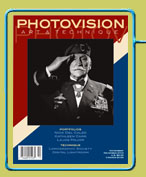By Robert Hirsch
From Vol. 4 No. 1
 © Robert Hirsch. Montage from the series World in a Jar: War & Trauma, 2003. 11 x 17 inches. Electrostatic print. |
It was a cold spring evening in Boston as I sat in a funky Brazilian restaurant near the Museum of Fine Arts with a group of printmakers discussing the invasion of Iraq. I mentioned a project I have been working on for years that wrestles with tragedy and memory and got invited to participate in a portfolio entitled “Shock and Awe.”
Organizer Tim Dooley, of the University of Northern Iowa, asked thirty artists, from Hawaii to the United Arab Emirates, to make a Xerox print about the issues surrounding the invasion and produce 32 copies. Dooley says, “The issue is complex and I expect a variety of responses between anti- and pro-war sentiments.” Each print has an image on front and a statement on the back. The editions are collated and returned to the participants, save two, which are used to secure exhibition venues and homes in collections. In the spirit of Felix Gonzalez-Torres, venues accepting the portfolio will make copies of the prints available to the public free of charge. This reflects a history from Francisco de Goya to John Heartfield of artists using inexpensive reproducible printed matter to respond to human suffering and affect social change.
“Shock and Awe” premiers this fall at the University of Northern Iowa Gallery of Art and then begins a tour that presently includes Macalester College, St. Paul, Minnesota, Univer-sity of Wisconsin-Madison, and Georgia College and State University, Milledgeville, Georgia.
The current geopolitical climate focuses attention on fantastic, mythical, and horrific photographs and people’s response to such imagery. The print I submitted to “Shock and Awe” is a montage of twenty images from my project “World in a Jar,” a collection of images in glass bottles that uses a freeflowing pictorial syntax to examine cultural topics. This selection derives from the American Civil War, World War I & II, Iraq, and pop imagery as well as my own photographs. This compilation of specimens intermixes portraits of military and political leaders, soldiers and civilians by re-photographing small sections of images using intrinsic photographic methods such as angle, cropping, focus, and directional light. Two identical images are printed on a piece of paper, which is rolled and placed inside a clear 32-ounce glass jar with a black top. The jars are arranged in thematic groups that can be handled and reconfigured by viewers. When the jars are picked up, the image is visible from either side. The intent is to dismantle predetermined hierarchies and encourage an interchangeable narrative that generates its own shifting drama that considers the fundamental condition of tragedy and life; the antithetical position of humanity undecidedly suspended between affirmation and negation of existence.
At one time, it was hoped that such images would reduce the desire for war, but this has not been the case. However, this does not diminish their power to make us think about one of humankind’s oldest and most distressing group activities.
For information about the “Shock and Awe” portfolio and exhibition contact Tim Dooley at: tim.dooley@ uni.edu.
